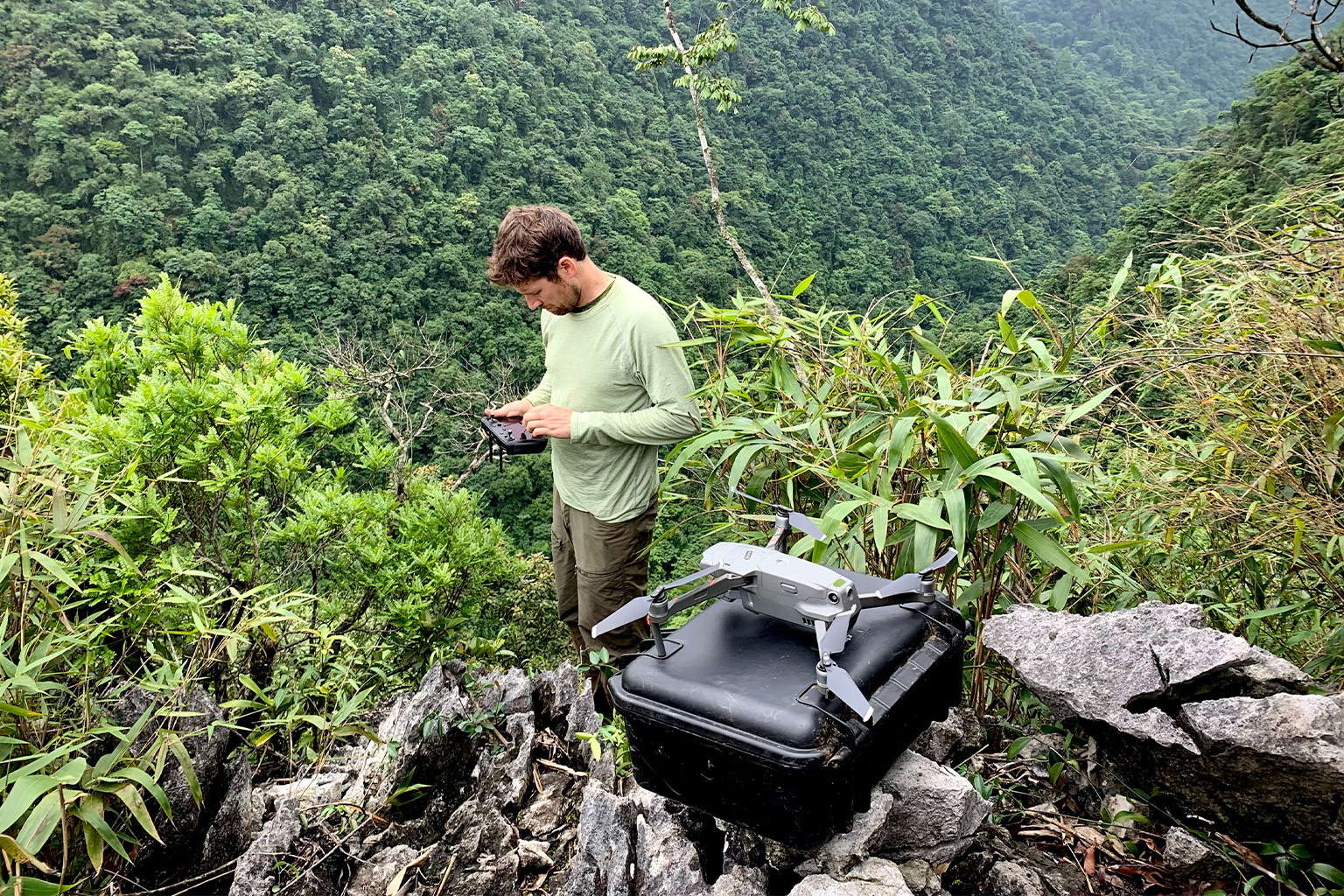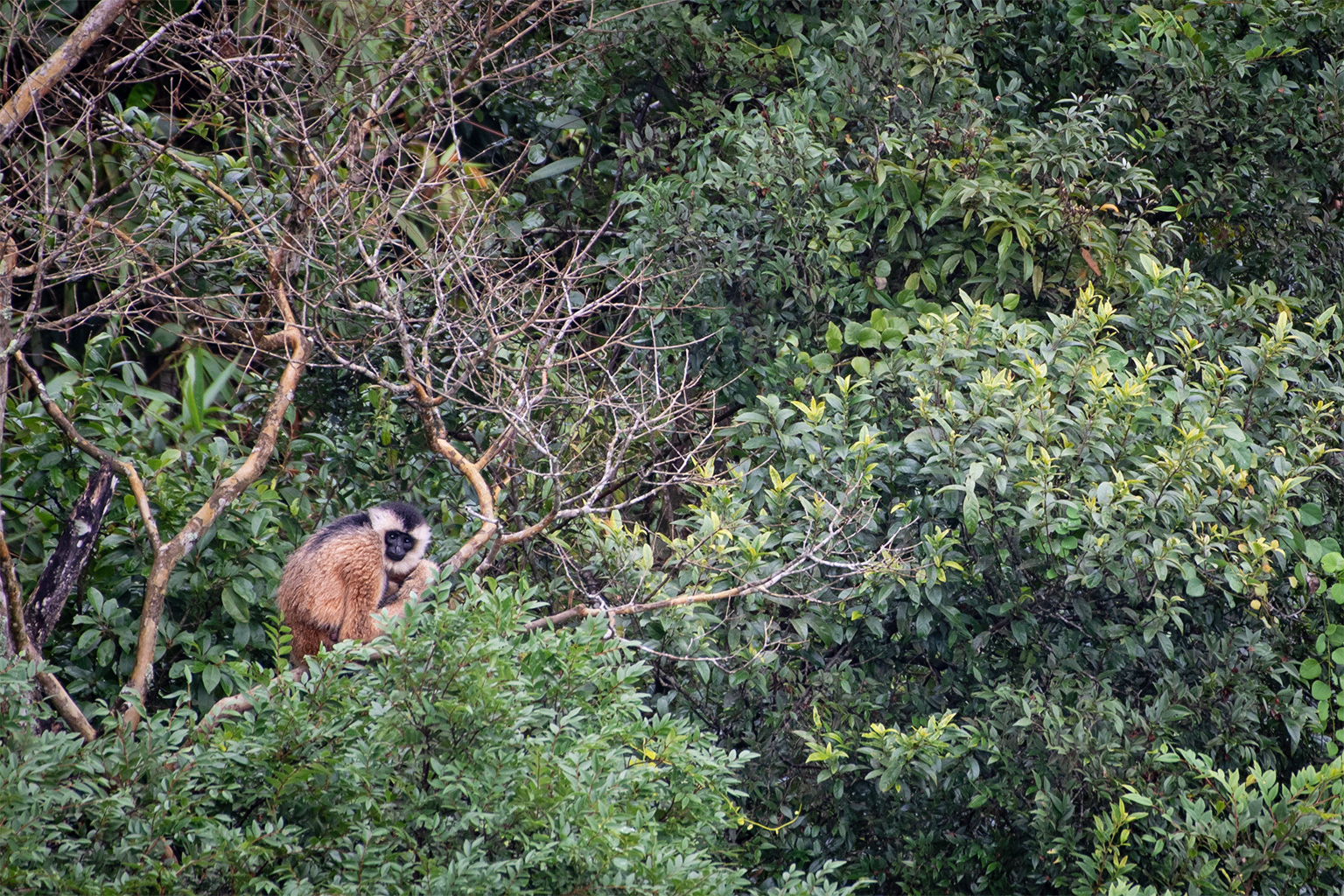- A survey using drones has come up with a more accurate, albeit smaller, population estimate for the critically endangered Cao-vit gibbon in the border region between Vietnam and China.
- Researchers emphasize the lower estimate isn’t the result of a population decline, citing the discovery of new gibbon groups.
- The finding, they say, “feeds into our assessments of how viable the population is [and] helps us decide what conservation actions are the most urgent.”
- The survey is the latest to underscore the “limitless” utility of drones and their growing importance in wildlife surveys and wildlife research in general.
Drones flying above the treetops of a limestone forest on the border of Vietnam and China are helping conservationists develop plans to recover one of the world’s rarest primates: the Cao-vit gibbon (Nomascus nasutus), which is considered critically endangered.
Researchers flew drones across Vietnam’s Cao-Vit Gibbon Species and Habitat Conservation Area and China’s Bangliang National Nature Reserve from late October to early November 2021, directed by ground spotters. Overall, the data gathered proved more accurate than past surveys that had overestimated the number of gibbons, according to research recently published in the journal Oryx.
“This drone data helps tell us that basically the population is smaller than we originally thought,” study lead author Oliver Wearn, a senior technical specialist at conservation NGO Fauna & Flora International, told Mongabay in an interview.

Past population surveys were carried out on foot and estimated around 120 gibbons in the wild.
The team has not yet released its new population estimate — combining data from ground, drone and acoustic surveys — as the full paper is still under review, but says the numbers will be lower than previous estimates. However, Wearn said, the smaller number will be a result of “more accurate” data, not the result of a population decline. “We don’t think it’s declined as we have evidence of new groups forming,” he said, with two new gibbon groups found in China as a result of the drone survey.
Cao-vit gibbons were presumed extinct until 2002, when their remaining population was rediscovered by scientists. Past hunting and habitat loss drove the species to its current isolated and highly degraded forest patch; it’s believed the species previously roamed forests across southern China and northern Vietnam.
Researchers used red-green-blue and thermal imagery to track gibbons. They proved useful for counting individuals and assessing the makeup of groups, identifying females with young. There are limitations to using drones, according to researchers: costs are currently high, battery life for monitoring over long distances is a concern, and there are ethical considerations as wildlife can be disturbed.
That said, Eva Gazagne, a biologist at Liège University in Belgium, who was not involved in the study, said drone surveys “could be a great method for long-term monitoring of this small population.” She uses this tech in her own work surveying other primates in Vietnam such as endangered red-cheeked gibbons (Nomascus gabriellae) and the critically endangered Delacour’s langur (Trachypithecus delacouri).


“Arboreal primates are difficult to detect and count from the ground. Add thick vegetation and uneven terrain to the mix and reliable, repeatable surveys become costly, time consuming, or downright impossible to achieve,” Brandon Semel, a biologist with the U.S. Fish and Wildlife Service, who was not involved in the study, told Mongabay by email. “I’m excited to see greater use of multiple camera systems (especially thermal imagery) of UAVs. Clearly the impacts will be most profound for rare, hard to count species like the cao vit gibbon.”
Accurate population numbers are the foundation of targeted conservation action to help this species recover, Wearn said.
“We do need to know the number of individuals because it feeds into our assessments of how viable the population is,” he said. “Most importantly, it helps us decide what conservation actions are the most urgent. When a population is so small like this, we actually need to increase its size through restoration.”
Based on research, the Cao-vit gibbon’s current occupancy of its habitat is thought to be around 30-40%, meaning there’s still space for it to expand. “But the habitat is really degraded,” Wearn added. “It is probably existing in the worst gibbon habitat in the world.”
Drones may also prove vital in driving necessary restoration efforts by aiding habitat mapping and the creation of 3D forest models. Conservationists could use such data to identify “where best to plant trees, enrich the forest, and hopefully improve the habitat quality for the species,” Wearn said.
Drones are likely to underpin ongoing efforts to conserve the Cao-vit gibbon, but they could also do so for multiple other species, according to researchers. “This study adds to our growing body of evidence that UAVs are going to play an increasingly large role in wildlife surveys and wildlife research in general,” Semel said. “The applications are limitless, especially for arboreal animals in difficult to access, remote forest areas.”
Banner image: Drone data gathered by conservationists with the NGO Fauna & Flora International, in partnership with the Forest Protection Department in Trung Khanh district, enabled more accurate assessments of the Cao-vit gibbon population numbers. Based on their findings, habitat restoration is considered the key conservation action to undertake. Image © Nguyen Van Truong/Fauna & Flora International.
To save Hainan gibbons, Earth’s rarest primate, experts roll out the big tech
Citation:
Wearn, O. R., Trinh-Dinh, H., Le, Q. K., & Nguyen, T. D. (2023). UAV-assisted counts of group size facilitate accurate population surveys of the critically endangered cao vit gibbon Nomascus nasutus. Oryx, 1-4. doi:10.1017/s0030605323000017
FEEDBACK: Use this form to send a message to the author of this post. If you want to post a public comment, you can do that at the bottom of the page.
